Physical Address
304 North Cardinal St.
Dorchester Center, MA 02124
Interstitial spindle cell proliferation
Collagen trapping
Overlying platelike acanthosis
Follicular induction common
Ringed lipidized siderophages or perivascular collagen donuts may be present
Factor XIIIa+
CD34−
All dermatofibromas demonstrate a proliferation of fibrohistiocytic cells. A curlicue pattern is typical. Another typical feature is that some areas of the tumor will be densely cellular, whereas others are sclerotic and hypocellular. The overlying epidermis is acanthotic and often demonstrates primitive follicular germs or sebaceous follicles. At the periphery of the tumor, collagen trapping (collagen balls) can be seen. The tumor may extend into the superficial fat in a lacy pattern.
When present, ringed lipidized siderophages are pathognomonic for dermatofibroma. These cells are like Touton giant cells with hemosiderin. They have central pink cytoplasm surrounded by a wreath of nuclei. There is both lipid and hemosiderin peripheral to the ring of nuclei.
Immunostaining can be helpful to separate cellular dermatofibromas from dermatofibrosarcoma protuberans. Large stellate cells within a dermatofibroma stain for factor XIIIa. The surrounding stroma will stain for CD34, but the central tumor is negative (except for endothelial cells).
Densely cellular tumors are suspicious for dermatofibrosarcoma protuberans, even if overlying acanthosis and collagen trapping are present. CD34 and factor XIIIa staining should be performed.
Long fascicles of parallel nuclei suggest a melanocytic tumor. Nodular lymphoid aggregates suggest desmoplastic malignant melanoma. S100 staining should be performed.
Corkscrew nuclei running parallel to the epidermis suggest a dermatomyofibroma.
Factor XIIIa is positive in dermatofibromas, fibrous papules of the face, angiofibromas, acquired digital fibrokeratomas, and pleomorphic undifferentiated sarcoma.
CD34 is positive in dermatofibrosarcoma protuberans, pleomorphic fibromas, sclerotic fibroma, spindle cell lipoma, and nephrogenic systemic fibrosis.
CD34 expression is lost in morphea.

Type of dermatofibroma
Aneurysmal dilatation of vessels

Type of dermatofibroma
Large, histiocytoid, vesicular nuclei with prominent nucleoli
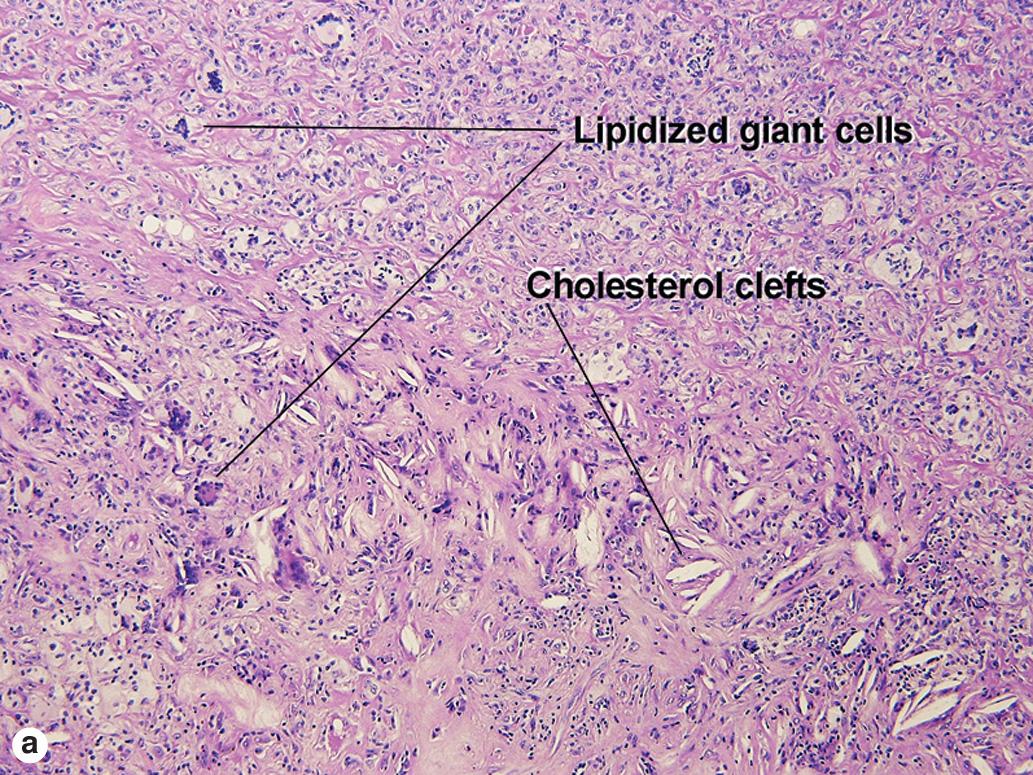
Very large cells with vesicular nuclei and prominent nucleoli
Sometimes hyperchromatic
Despite large alarming cells, these are completely benign lesions

Increased small capillaries and venules in the upper dermis
Interstitial multinucleated cells
Slightly thickened collagen bundles
This lesion is of uncertain histogenesis and may be reactive rather than neoplastic. Middle-aged to elderly women are most commonly affected with solitary or multiple grouped red-brown to violaceous asymptomatic papules to plaques on the dorsal hands, thighs, and legs.
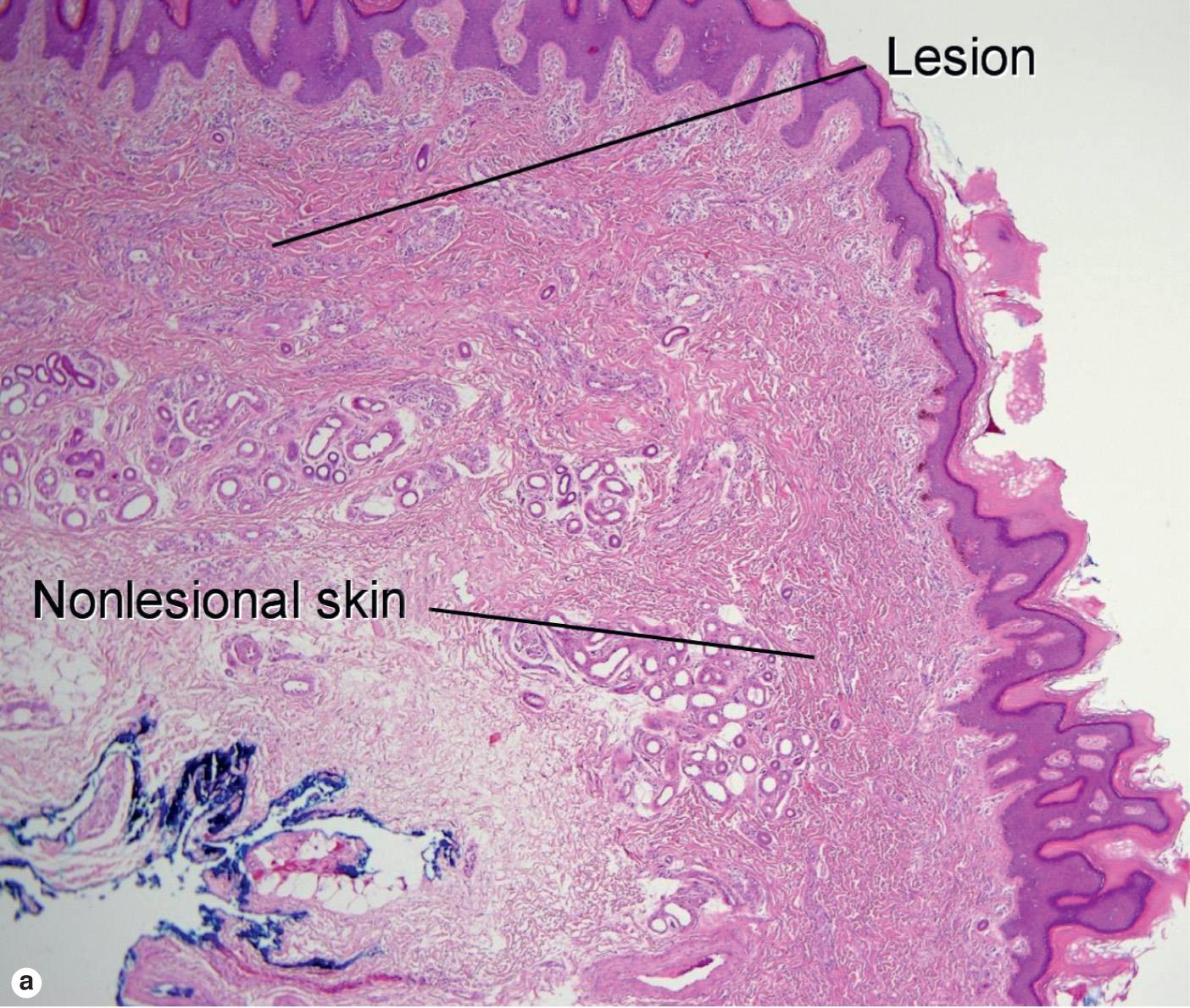
Nodules with blue centers
Myofibroblasts
Peripheral fibrovascular proliferation
The shade of blue in the center of the nodule resembles that of cartilage. The peripheral vascular proliferation may have staghorn vessels and resemble hemangiopericytoma.

Fascicles of corkscrew myofibroblasts
Lacks blue hypocellular nodules and surrounding vascular proliferation
Plaquelike tumor
Spindle cells with east–west orientation
Proliferation “respects” (doesn't displace) adnexal structures
Corkscrew appearance of some myofibroblast nuclei
Thick elastic fibers visible with Verhoeff–van Gieson stain
At scanning magnification, the most striking features of a dermatomyofibroma are the horizontal orientation of the spindle cell nuclei and the pattern of the proliferation with respect to the adnexal structures, especially hair follicles. The follicles are normal in appearance, and the proliferation extends up to each follicle, then continues on the other side without any displacement of the follicle.
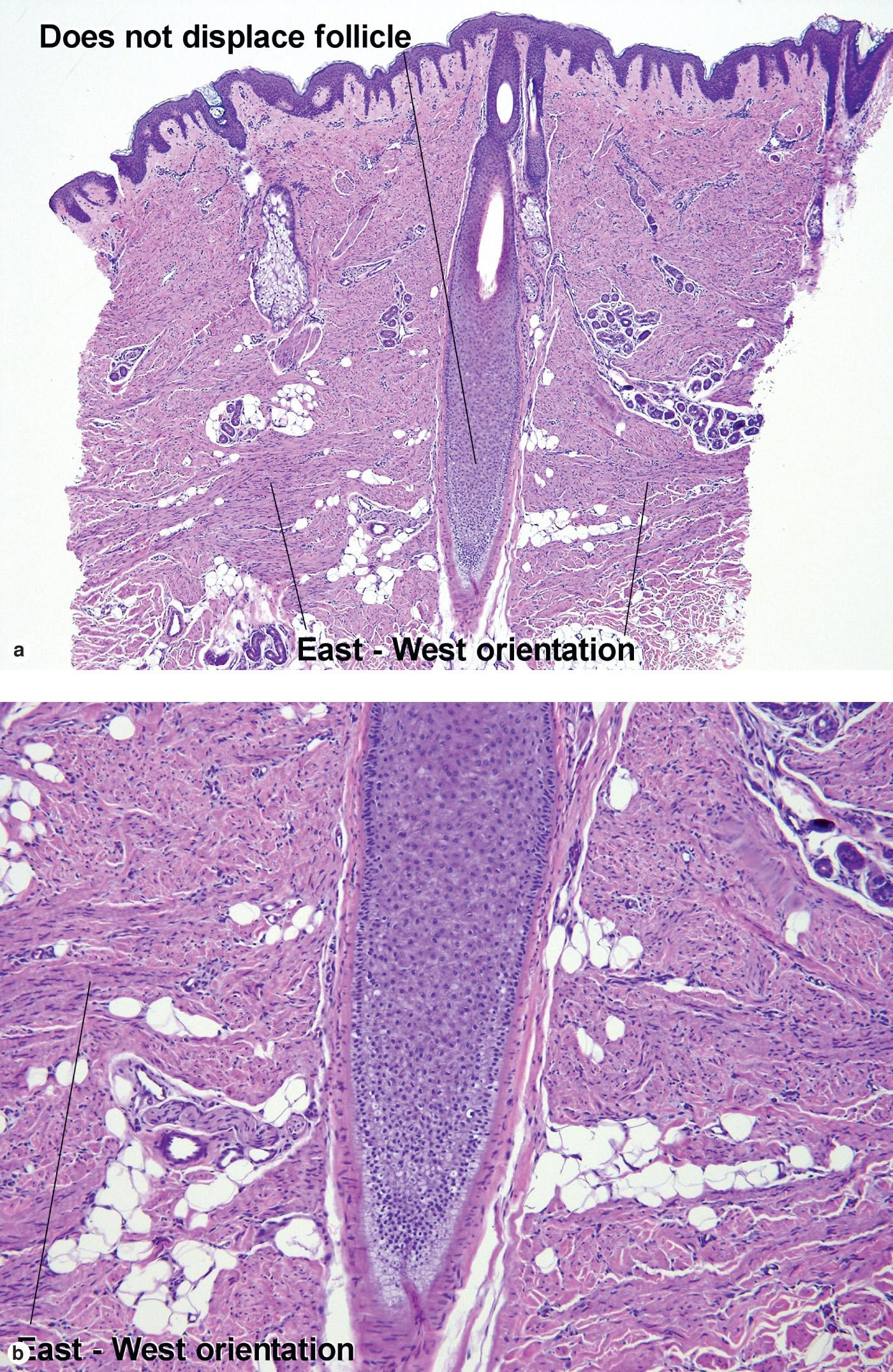
Myofibroblastic proliferation
Locally infiltrative, but does not metastasize
Corkscrew-shaped myofibroblasts
The fibromatoses include Dupuytren (hand) contracture, Peyronie (penis) disease, and Ledderhose (foot) plantar fibromatosis. All forms demonstrate corkscrew-shaped myofibroblasts and collagen. Ledderhose disease tends to form large, whorled nodules.


Myofibroblastic proliferation
Locally infiltrative, but does not metastasize
Corkscrew-shaped myofibroblasts
There is a tendency toward spontaneous regression. Superficial disease has an excellent prognosis. Visceral involvement may be fatal in some cases. In one series, more than half of the lesions were present at or soon after birth, approximately 80% were solitary, and 50% involved the head and neck. In the early stage, undifferentiated immature histiocytic cells may predominate. As the lesion matures, they develop characteristics of myofibroblasts. Regressing lesions become progressively less cellular and more fibrous.

Autosomal recessive
Nodular skin lesions of the hands, scalp, ears, and central face
Gingival hypertrophy
Joint contractures and osteopenia
Nodular hyaline fibrosis in the dermis
Linked to CMG2 or ANTXR2 mutations (gene encoding capillary morphogenesis protein-2 on chromosome 4q21)

Fibroblasts with east–west orientation
Blood vessels with north–south orientation
Loss of elastic tissue (see Chapter 13 )
Whorled proliferation of fibroblasts and blood vessels
Whorled proliferation of fibroblasts and blood vessels
Central bundles of amorphous “bubble gum” collagen
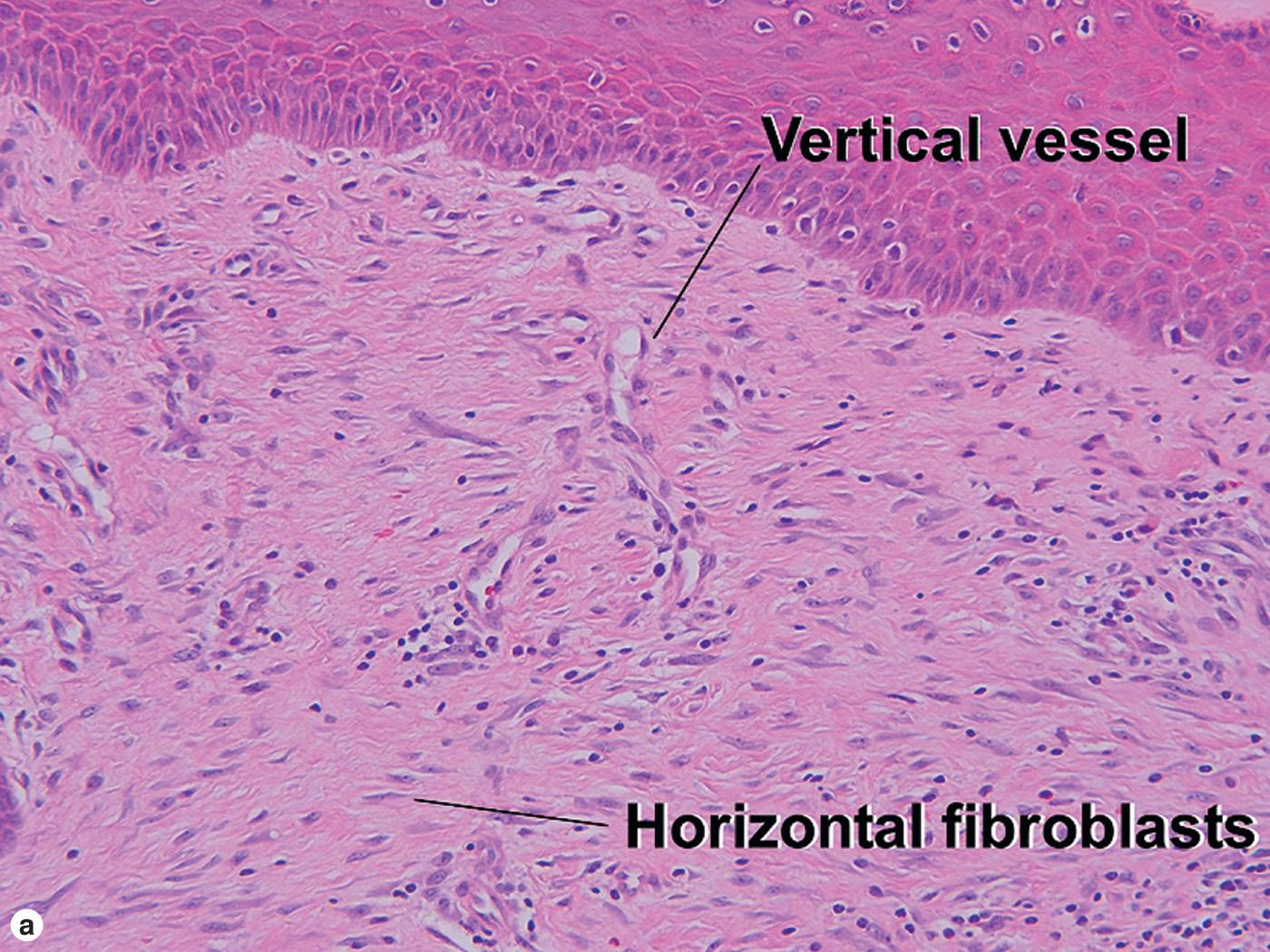
Cystic space lined by villous, synovium-like projections
Some villous projections are fibrinous
This intradermal nodule usually occurs at the site of previous surgery or other trauma. This is a pseudocyst without true epithelial lining. Often inflamed granulation tissue or scar is present. Multinucleated giant cells and multiple normal mitotic figures may be noted.

Disorderly growth of benign tissues
Myxoid areas, mature fibrous areas, and fat
Organoid (compartmentalized) appearance
Surrounding skin has features of “kid” skin
A young child's skin (“kid” skin) is characterized by delicate collagen bundles that stain deeply red. Many fibroblast nuclei are present. Lipocytes and adnexal structures tend to be small.
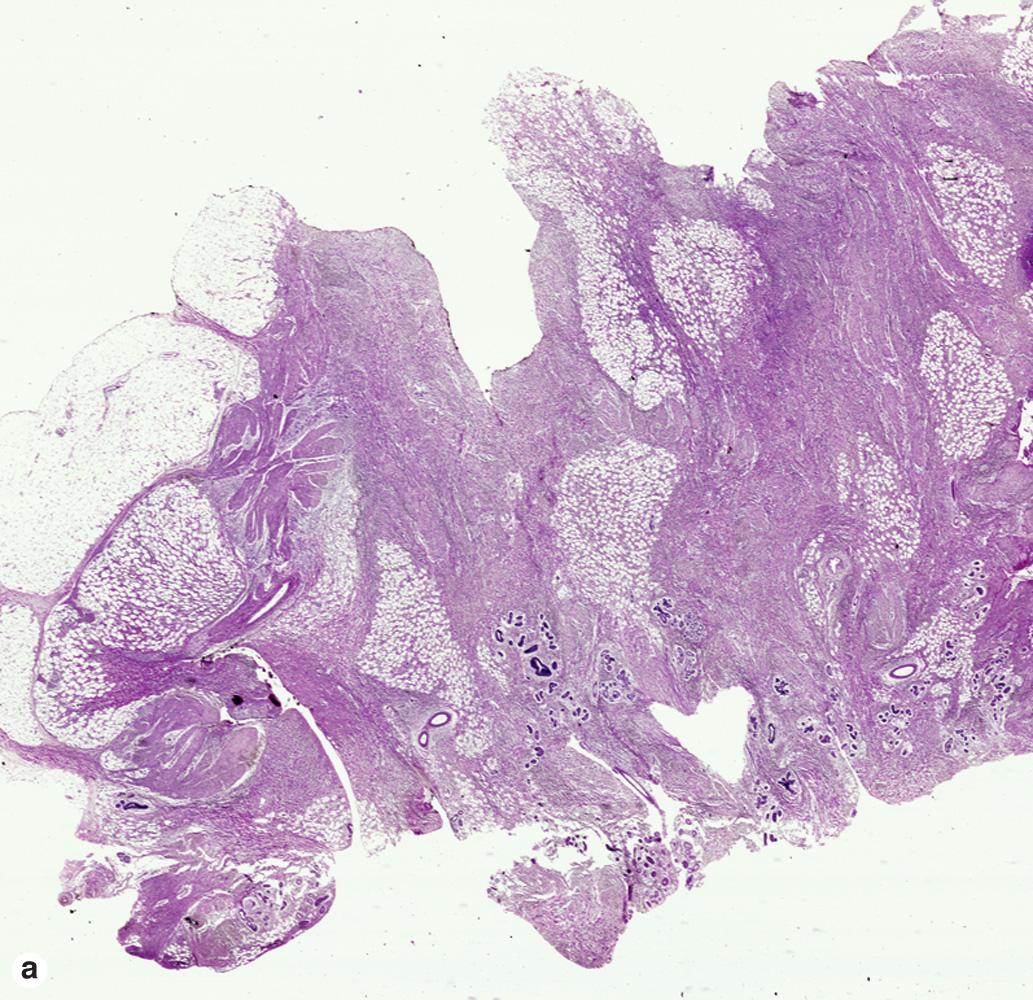
Become a Clinical Tree membership for Full access and enjoy Unlimited articles
If you are a member. Log in here